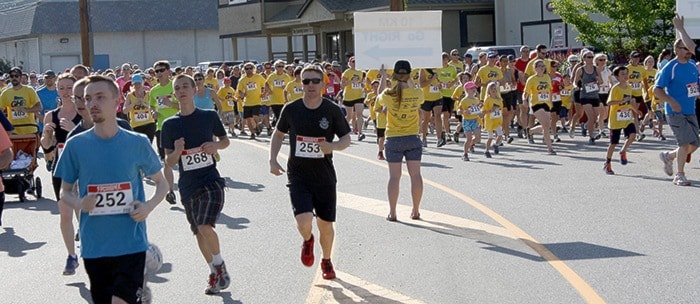With the season of spring and summer running races around the corner, who wouldn’t want some running tips from Olympic runner, Malindi Elmore?
Elmore competed for Canada in the 2004 Olympics as an 800-metre 1,500-metre specialist.
She ran for Stanford University setting school records and was a five-time All-American.
She retired from Team Canada in 2012, had her son Charlie in 2014, and a year later competed in a half Ironman and turned pro after her first serious race.
She can pound off a 10-kilometre race in 33 minutes.
She and her husband Graham Hood (also an Olympic runner), organize the Apple Triathlon in Kelowna, and she is an online coach for running. www.canadianrunner.ca.
Here are Malindi Elmore’s top tips:
Walk/Run Programs
Elmore explains, ‘For beginners, it’s just too much to start with a running program.
There is so much force on your body when you run, something like seven times your weight with every stride. That’s about 1,000 pounds of force for a 140-pound person.”
For people who are just starting out, just getting back into sport, coming off injury or postpartum, a walk/run program is your best bet.
Shorten your stride
“People tend to over stride,” Elmore warns us. “A long stride isn’t a bad thing, but you don’t want to be running with your leg extended in front of you and landing on your heel.”
With heel striking, force is not being absorbed in your body and injury can occur.
“You want your foot to land under your body as your body moves over it. You should be landing mid-foot.”
Do you need to shorten your stride?
Variety and Easy Running
Elmore says, “If you do the same training all the time, you can expect the same results.” To spice your running regiment up, she recommends intervals, hill sprints, and low intensity volume injected with shorter, higher intensity for a good mix. If you are training 5x/week, the breakdown can be two days of interval training with shorter higher intensity running, 1 long run day and 2 easy days.
Elmore reminds us, “The easy days in running should be really, really easy. The purpose is recovery. There are huge aerobic benefits of low intensity training after good volume. If you look at pro marathon runners who train 100 miles a week, 70 miles are low aerobic effort.”
Core is More
“Core training is more important than stretching for running,” Elmore explains, “You want a good core, proper alignment and general strengthening. Many runners have weak gluts that are not firing properly. It’s important to have good form. “
Elmore spends more time gaining strength in the gym than working on flexibility or stretching after running.
She explains that sometimes being over flexible is a detriment for runners.
If the Shoe Fits
Buying shoes that are properly fitted for running is important.
Elmore advises going to a good running shoe store rather than picking out shoes for price, or colour.
If you head to a specialized shoe store such as Peach City Runners in Penticton or Fresh Air Experience in Kelowna, the staff will look at how you walk, if you pronate or supinate, and find the most supportive shoe for your foot and gait.
Joanne Malar is the program coordinator for Summerland Recreation, three-time Olympic swimmer, 2012 Olympic Commentator, kinesiologist and holistic nutritionist.
